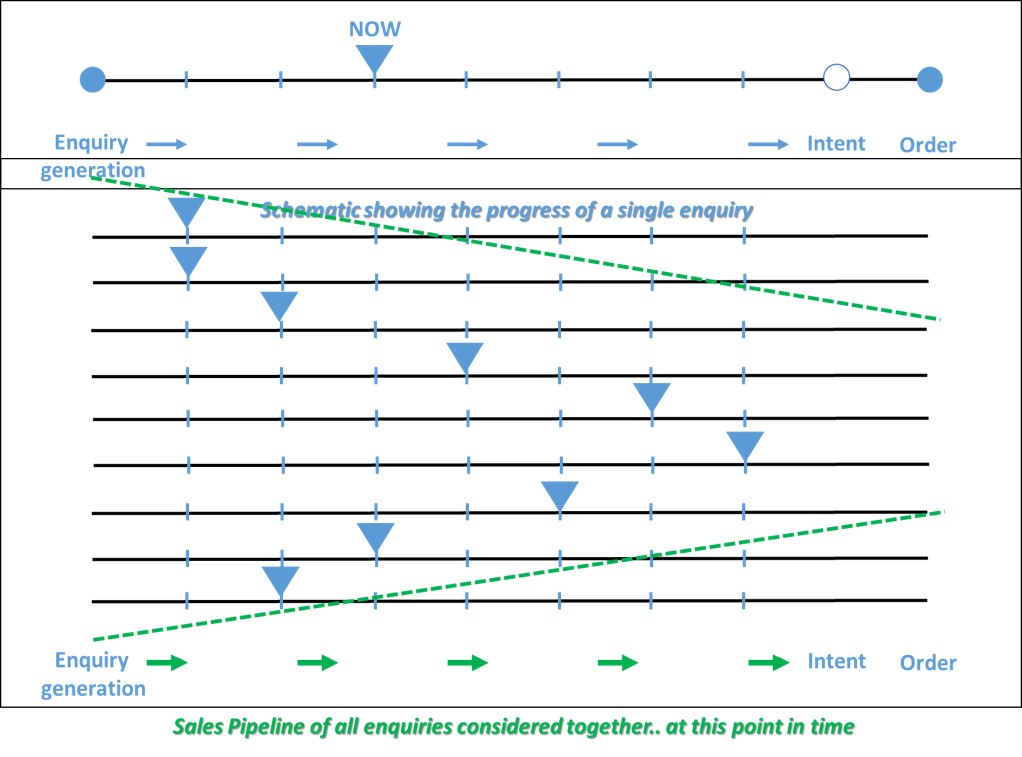Can you answer these three questions?
- “Sales forecasting is an art”. What is your reaction to this emphatic statement?
- What is the difference in sales planning for: Several deals each of small value versus few deals each of large value?
- Name at least 4 stakeholders likely to be interested in Sales Forecasts in a typical company. Rank them in terms of criticality of this information.
Can you solve these three problems?
- A 50 years old industrial power tools company went through bad patches but has now recovered well. Due to this fact the sales team has about half the number who are in company for long and half the number who are 2 to 3 years old. The two groups often have different approaches to selling. The company makes compressors. Business lines are divided between trade business (small capacities sold through a network of distributors), and direct sales (mostly large value, tender based orders from Public and Private sector companies). The old salespeople group in the team holds a view that all tender orders get decided based on pre-tender sales and a senior Salesperson need not waste time on it after attending the tender opening. New groups do not agree and feel that tracking enquiries well after opening of the tenders is all the more important. What do you feel?
- A Machine Tools Manufacturer is convinced of using a set of questions to track deals in pipeline. The idea is that yes as an answer to the question would tell them that they stand a better chance to win order vis-à-vis competition. So, a group is charged with the task of working out a set of such questions. The discussions have got stalled at the following question: ‘Does this customer give importance to After-sales-service?’ A salesperson says this question should be as it is for some product lines; but for others it should be ‘Is it true that this customer does not require extensive after sales service?’ Everyone is very surprised, but since the salesperson is well respected his observation has set them thinking. Why do you feel he is saying so?
- Sales Director of Classic Furniture Systems uses Sales Funnel concept to review the large enquiries and to decide prioritizing of strategic attention to various enquiries. Typically there are about 50 enquiries in the Zonal pipeline at any given time. At one such Zonal review he asked a salesperson for enquiry under discussion: “Tell me, are you confident that we will get this order or not? I hope that the deal is at the bottom of your sales funnel and not at the top.” The salesperson replied: “Sir, it is at the top of my sales funnel and that is why actually I thought of bringing it to your attention for support to me”. Sales Director got offended by the cross answer but checked himself from reacting immediately. He asked the salesperson why he feels so, only to find that there was a very sound rationale for his request. What could have been the rationale?
SALES PIPELINE
We define sales pipeline as the collection of all enquiries generated, enquiries received and offers made as on given date. Each enquiry in the pipeline will be at a different milestone of its journey from enquiry generation stage to order stage. The ‘sales pipeline’ should be expressed as potential probable total value of all such enquiries, allowing for some inevitable failures to win an order. The process of such totalling probable value is nothing but sales forecasting.
If you are doing this exercise not passively (simply totalling the pipeline without any proactive actions) you are not doing true sales planning. Hence the sales pipeline needs to be monitored consciously, actions decided and implemented consciously and review of sales planning done at appropriate frequency to achieve better sales results.

Three possible scenarios are:
A. Several small size deals being worked upon in the sales pipeline.
The position of arrow (“NOW”) indicates a milestone. Total journey time of each deal is relatively small. The milestones can be assigned a probability of winning that order. Extreme left would be 0% while rightmost milestone should be taken as 90%. Typically 4 milestones are defined to mean 60%, 70%, 80%, 90%. If each potential order value is multiplied by % factor at that milestone and totalled that would be the probable total value sales forecast of pipeline.
B. Few large size deals in the sales pipeline.
Method adopted in A cannot be used for sales forecasting in such a scenario since there is no ‘balancing’ that can happen. Also the journey time of each deal would be long. Probability of success needs to be monitored at not only 4 milestones but almost at every point.
C. Combination of A and B.
We look at sales planning (both efforts and results) for scenario B, in this article.

For sales planning (deciding efforts to be put in to achieve desired results) in above scenario, the method of sales forecasting as used in scenario A for “many-enquiries-each-small” would not work. You can/should calculate the sales forecast for each enquiry by using what we call a Tactical Checklist method:-
List 30 to 40 questions in such a way that an answer “yes” to that question implies some chances of you winning this order. A few examples are as follows.
- Is the requirement of customer within our range of products / activity?
- Do they have funds?
- Are we approved?
- Do we have a champion there?
- Does the customer know our company’s strengths/capabilities?
- Do we have a better hold than our competitor?
- Is the customer amenable?
- Do we have a unique product/service advantage?
- ____________________
- ______________________
- _________________________
- _____________________________
- Split these questions into three lots of essential factors for success, desirable and useful. Allot marks: 3 for each essential question, 2 for desirable and 1 for useful. Juggle these so that when all questions are answered yes, it yields a total score of 90%.
Evaluate the status of each enquiry. Any questions for which the answer is no earns 0 marks. For other questions you can add a further refinement if you like by giving weight for three levels of “degree of certainty” with which you can say yes.
This analysis gives you the following:
- You know status of your offer. Total score can vary from bare minimum level of say 50% to maximum 90%. If you do not have information ruthlessly give 0 marks.
THE KEY IS TO FORMULATE GOOD QUESTIONS AND DESIGN AN EFFECTIVE SCORING SYSTEM.
Can you now look again at your answers to the questions at the start of this insight document?




